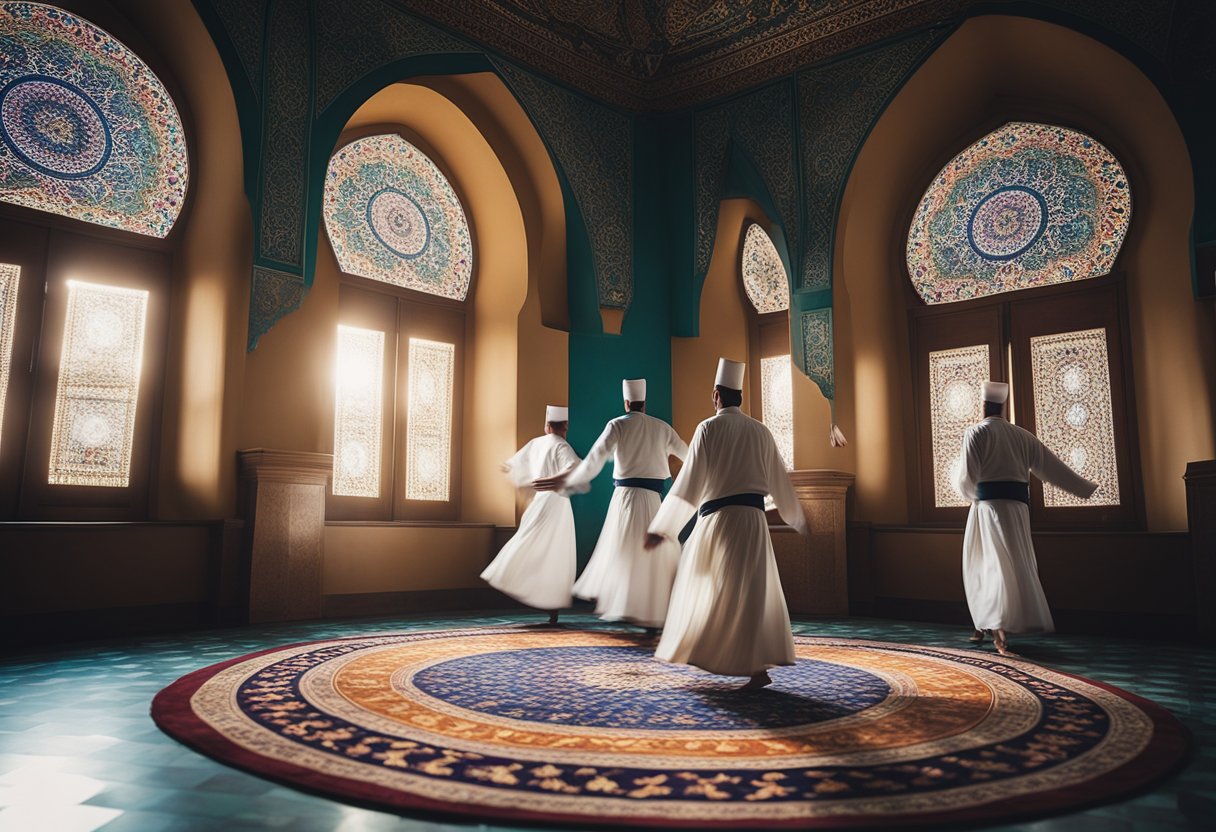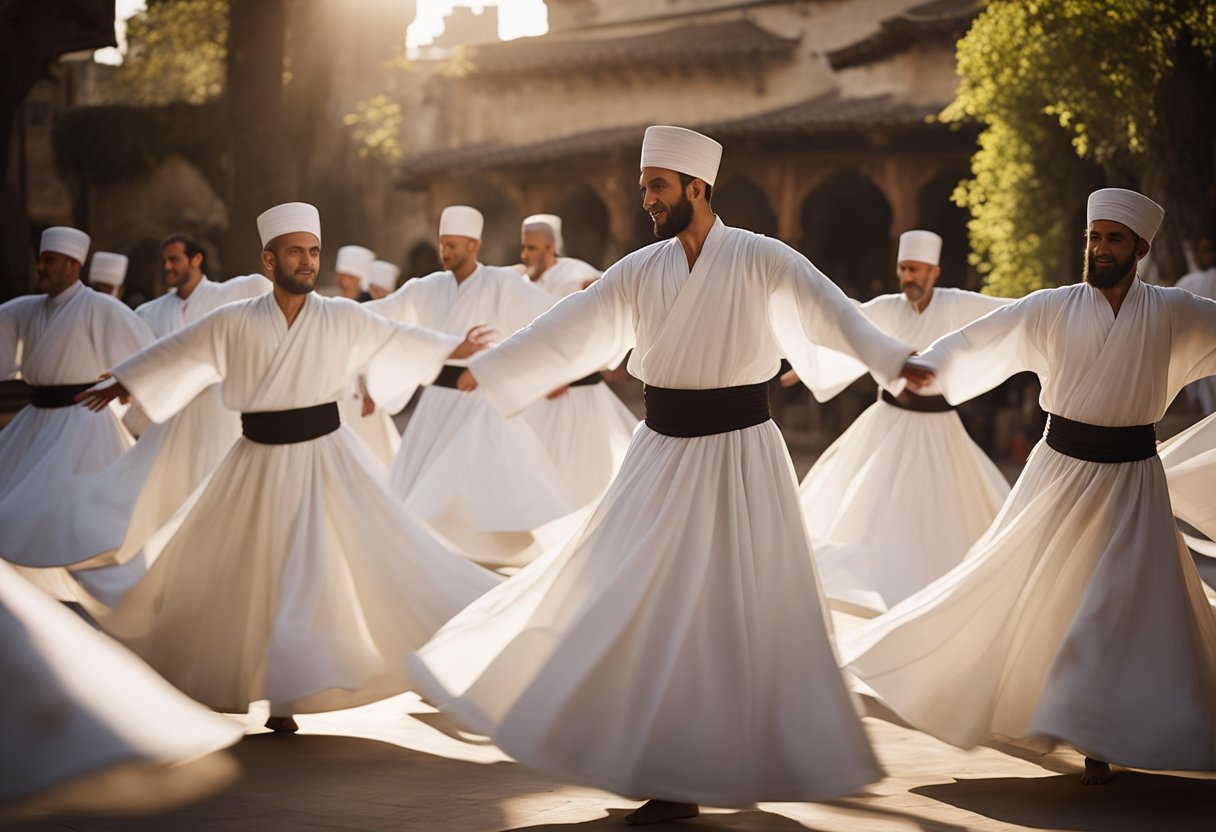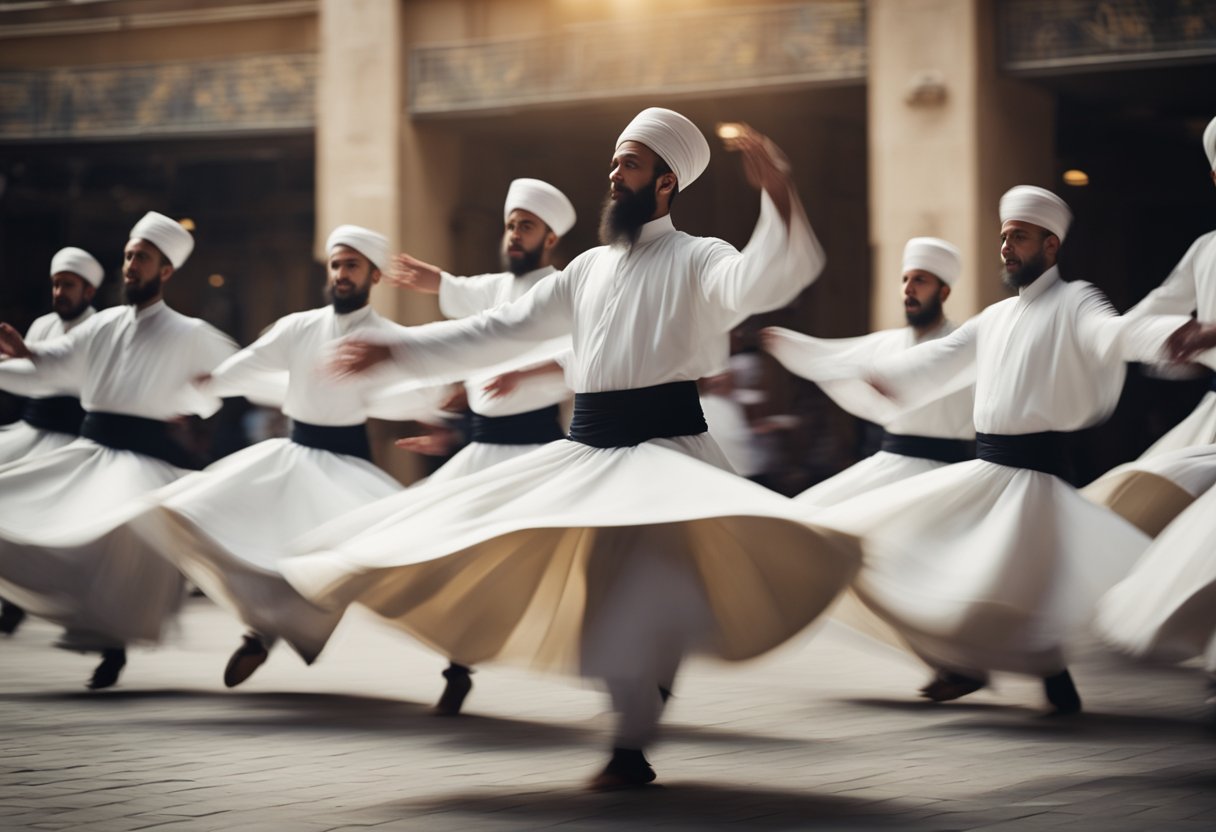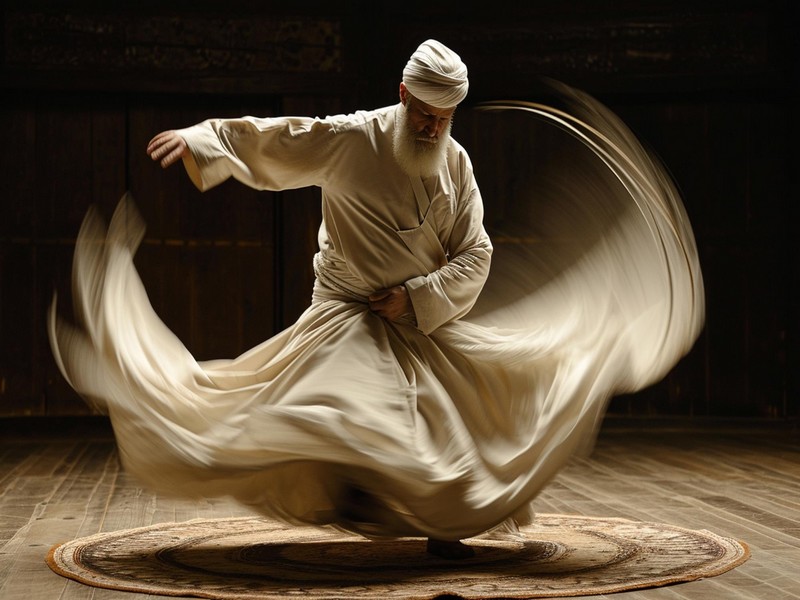The Whirling Dervishes of Türkiye: Exploring the Spiritual Dance of Sufis

Updated On: April 15, 2024 by Aya Radwan
The Whirling Dervishes of Türkiye represent a form of spirituality in motion intricately connected to Sufism’s profound and historic presence in the region. This tradition, deeply rooted in the mystic practices of Sufism, transcends mere performance, embodying a ritual that is both a meditative act and a spiritual journey. The Sema ceremony, where dervishes spin continuously in perfect harmony, encapsulates the unity of thought and action as they seek connection with the divine.
Holding a symbolic significance that has thrived for over seven centuries, the practice of the Whirling Dervishes is an enchanting interplay of movement and music. It illustrates the Sufi quest for a transcendent state, where music and poetry are integral to the experience, guiding participants and observers alike towards a deeper understanding of mystical love and divine worship. Recognised by UNESCO for its cultural importance, this living tradition continues to captivate audiences worldwide, revealing layers of spiritual meaning with every turn.
Historical Context of Sufism
Sufism represents the mystical branch of Islam that seeks to find divine truth and love through direct encounters with God. Historically, it has greatly influenced Turkish culture and spiritual life.
Rumi’s Influence on Sufism
Jalāl ad-Dīn Muhammad Rūmī, known simply as Rumi, was a 13th-century Persian poet and Sufi mystic whose profound influence on the world of Sufism cannot be overstated. His poetry and teachings centred on the pursuit of ecstasy in union with God, the loving and personal aspect of the divine. Rumi’s works transcended national and ethnic borders and played a pivotal role in the Sufi practice, shaping the esoteric aspects of Islamic thought even today.
The Foundation of the Mevlevi Order
The Mevlevi Order, founded by Rumi’s followers and led by his son Sultan Veled, is among the most well-known Sufi orders. Established in 1312 in Konya, it is noteworthy for its Sufi whirling, a form of active meditation, symbolising the cosmos’s divine order. The Mevlevi Order fosters the idea that through a ritualised dance known as the Sema, one can achieve a state of spiritual ecstasy and union with the divine, reflecting Rumi’s teachings.
Sufism under the Ottoman Empire
Within the Ottoman Empire, Sufism thrived, and the Sufi monasteries became centres of learning and spirituality, permeating various aspects of life and culture. The mystics were regarded as men of God, deeply admired and sometimes feared for their insight and influence. Under Ottoman patronage, Sufism expanded greatly, integrating with the arts, architecture, and society, becoming an indelible part of Turkish culture.
The Semazen and Sema Ceremony
In our exploration of the Sema ceremony, we observe the profound spiritual display of the Semazen—whirling dervishes who turn into meditative trance as a path to divine communion. Their movements reflect a symbolic journey towards spiritual perfection.
Understanding the Semazen
The Semazen, or whirling dervishes, participate in the sacred Sema ceremony. They undertake this spiritual journey, known as seyr-u süluk, a form of the Sufi practice. Each movement and gesture holds profound meaning, from removing their black cloak, symbolising rebirth, to their arms crossing and opening, representing their unity with the divine. The Semazen don traditional attire, including the sikke, a camel hair hat, and white robes, which symbolise the ego’s shroud cast off to reveal purity.
The Semazen seek to utilise the Sema ritual as an avenue to connect with something far greater than themselves—an endeavour steeped in love, spiritual growth, and the quest to attain the divine. The music accompanying the ritual is central to the experience, with the ney, a reed flute, setting a melancholy atmosphere conducive to reflection and union with God.
The Symbolism Behind Sema
The Sema ceremony itself is rich in symbolic elements. Each aspect of the Semazen’s dress and motions conveys meaning. Their sikke represents the tombstone of the ego, and their wide skirts signify the shroud of the ego. The turning motion of the Semazen echoes the revolving nature of existence, from atoms to galaxies, epitomising the unity of all things.
The ceremony progresses through several phases, each with specific traditional prayers and movements, culminating in a reading from the Quran. The Sema aims not just to symbolise the spiritual journey but to engage in it actively, inviting participants and observers alike to contemplate the love and creation that flow from the divine. Through their persistent whirling, the Semazen demonstrate physically the internal search for sacred love and the divine essence that pervades all life.
Sufi Music and Poetic Elements
In our exploration of the swirling ceremonies, it is essential to consider the profound impact of Sufi music and poetry—tools that invite the essence of the divine into the world of the mystic.
The Role of Ney in Sufi Music
The ney, an end-blown flute, holds a special place in Sufi music, serving as a metaphoric voice calling out to the divine. This ancient instrument is said to symbolise the human experience, with its reed structure representing the soul yearning for spiritual transcendence. Select melodies produced by the ney are integral to Sufi ceremonies, believed to incite a deep emotional response that echoes the yearning for connection with the divine.
Poetry in Sufi Tradition
Sufi tradition intertwines deeply with the verses of Rumi, a 13th-century Persian poet and mystic whose works outpour love and the quest for divine ecstasy. His poetry often complements the zikr—the act of remembrance of Allah—used during Sufi rituals to evoke a state of communion with the spiritual realm. A dervish’s whirling, accompanied by Rumi’s verses, encapsulates a profound narrative of the soul’s journey towards ultimate truth and love.
Cultural Significance and UNESCO Recognition

In exploring the Whirling Dervishes of Türkiye, we uncover this art form’s profound impact on cultural identity and heritage, as recognised by UNESCO.
Whirling Dervishes of Türkiye Culture
Whirling Dervishes, known for their mesmerising, graceful dances, are a cornerstone of Turkish culture. Centred around the Sufism practice, this tradition represents a spiritual journey where dancers, clothed in flowing white garb, become engulfed in a trance, symbolising their union with the divine. The performance, more formally known as the Sema, is not merely entertainment but a sacred ritual illuminating the rich tapestry of Turkish cultural heritage.
Performers are meticulously trained, embodying the physical technique and the intrinsic spiritual dimensions that the whirling dervishes contribute to Türkiye’s cultural landscape. Each turn the dervishes take is meaningful, showcasing a philosophy of universal love and the harmony of existence.
Intangible Cultural Heritage of Humanity
In 2008, the art form of the Whirling Dervishes was inscribed on the UNESCO Representative List of the Intangible Cultural Heritage of Humanity. This recognition highlights the global significance of preserving practices encapsulating human creativity and cultural diversity.
UNESCO’s acknowledgement underscores the importance of safeguarding this intangible heritage for Türkiye and humanity. It encourages proactive efforts to protect and promote these unique cultural expressions so that they may continue to inspire and instil a sense of peace and unity among audiences worldwide. By celebrating the Whirling Dervishes, we celebrate an art form that transcends cultural boundaries, offering a poignant reminder of our shared human experience.
The Spiritual Practice Behind Whirling
In exploring the depths of Sufi tradition, we encounter the whirling dervishes, practitioners of a profound spiritual ritual. This practice, where meditation and movement converge, provides a pathway to a deeper connection with the divine.
Sema as a Form of Meditation
The Sema ceremony is at the heart of a dervish’s spiritual life, embodying a unique form of meditation. During this ritual, dervishes engage in a continuous, spinning dance, symbolising the revolution of all living things around the Sun and the divine truth. Their focus is inward as they whirl, fostering heightened spiritual awareness and a sense of peace within the soul. This dynamic meditation is a physical and transformative experience, reinforcing their commitment to a spiritual journey towards enlightenment.
The Concept of Divine Love
The essence of the whirling dervish’s movement is divine love, a powerful force that binds the universe and guides the soul’s quest for spiritual enlightenment. This love transcends earthly affections, defining the very fabric of Sufism. Dervishes seek to embody and express this profound love through whirling, channelling it as a form of worship and submission to the divine. It is a love that dissolves the ego, allowing the heart to become a mirror reflecting God’s love. In surrendering to this love, dervishes aim to achieve communion with the divine, peace within themselves and love for all creation.
Symbols and Attire of the Whirling Dervishes
In the captivating Sema ceremony of the Whirling Dervishes, each element of attire is steeped in meaning, from the tall hat known as a sikke to the sweeping white robes. These garments are symbolic of the dervishes’ spiritual journey.
The Significance of White Robes
The flowing white robes worn by the Whirling Dervishes, or semazen, symbolise purity and renunciation. When they don their white garments, it signifies their surrender to the divine and their separation from worldly attachments.
The Tall Hat: Symbolising the Tombstone of the Ego
The sikke, a tall camel’s hair hat, holds profound symbolic value, representing the ego’s tombstone. This powerful emblem constantly reminds the dervishes to cast away their egotistical inclinations and embrace humility.
The Psychological and Physical Aspects

Examining the Whirling Dervishes reveals a profound blend of mental focus and physical endurance. This section explores the psychological trance they achieve and the physical demands of their whirling practices.
Achieving a Trance-like State
The practice of whirling is a physical exercise and a deeply spiritual one. Dervishes enter a trance-like state facilitated by the continuous spinning, which symbolizes the journey towards spiritual ecstasy. Achieving this state requires immense concentration and a form of detachment from one’s immediate environment. The dervishes’ eyes may assume a soft focus or close partially, allowing their consciousness to turn inwards as they seek connection with the divine.
The Physiology of Whirling
Whirling for extended periods calls for significant physical balance and control. Every aspect of the dervish’s body is engaged, from maintaining an upright posture to controlling the direction and speed of their rotations. The posture is such that one hand is raised upwards, receiving from the heavens, and the other downwards, grounding to the earth. This precise physical alignment also contributes to the balance necessary to sustain the whirling without succumbing to dizziness.
Rituals and Process of the Sema
In unveiling the Sufi tradition of the whirling dervishes, it is pertinent to understand the rituals and the meticulous process encompassed in the Sema ceremony. This spiritual journey seeks divine harmony, using precise movements symbolising the soul’s voyage towards peace, unity, and surrender to the love of the divine.
The Order of the Sema Ceremony
The Sema ceremony unfurls with a strict sequence that captures the ethos of Sufism. This ritual begins with a praise song (Naat-i Sherif) and a drum sound symbolising God’s command ‘Be’ to the creation of the universe. Followers then embark on the seyr-u süluk (journey) with the “Devr-i Veledi”. They take an initial bow, confirming their surrender to the divine truth. The ceremony comprises four selams (salutations), each with rich symbolic meanings, from acknowledging the creator to expressing love and rapture. In this procession, dancers revolve around their hearts and the hall, representing the planets orbiting the sun – mirroring cosmic harmony.
Rituals Before the Ceremony
Before the ceremony, participants engage in several preparatory rituals reflecting the principles of unity, peace, and the cleansing of the soul. These rituals consist of communal prayers and donning traditional attire, with the black cloak symbolising the material world, which is cast off to unveil the white gown beneath – the ego’s shroud surrendered in the quest for the intangible. The sikke worn on the head signifies the ego’s tombstone; discarding the cloak marks spiritual rebirth. These pre-ceremony practices prime the dervishes for their subsequent spiritual immersion, aligning their intentions with the celestial aspirations of the Sema.
Modern Practices and Adaptations

In the world of Sufi traditions, the Whirling Dervishes have kept their spiritual dance alive, adapting to contemporary times while maintaining the essence of their centuries-old practice.
Whirling Dervishes Today
Today, the Whirling Dervishes continue to perform in Türkiye, with Konya and Istanbul being the principal cities where this cultural heritage thrives. Particularly, the Galata Mevlevihanesi in Istanbul has become a hub for visitors seeking to witness the enduring legacy of the dervishes. Modern practice often balances the needs of cultural preservation with tourism, inviting people from around the globe to observe this mesmerising Sufi ritual. While rooted in tradition, performances have adapted to reach a broader audience, blending solemn religious ceremonies with cultural presentation.
The Inclusion of Women
Traditionally, the spiritual practice of the Whirling Dervishes was exclusive to men. However, in recent adaptations, we’ve seen the inclusion of women in some Sufi groups. This shift reflects a broader movement within modern practice where the values of equality and contemporary views influence longstanding traditions. This has been a subtle yet significant change in Türkiye, denoting an evolution in how Sufi practices are perceived and experienced in today’s world.
Sufism’s Global Influence and Interpretations
Sufism has transcended its origins in the Middle East, evolving into a spiritual movement that resonates worldwide with its universal message of love and unity.
Sufism Beyond Türkiye
We observe that Sufism, although deeply rooted in Turkish tradition, has cast a widespread net, touching the hearts of people across various continents. The essence of this spiritual tradition has found its way into the practices and beliefs of many cultures, embodying a universal call for spiritual growth and a soulful connection with the divine. The practice of Sufism, animated by love and a longing for spiritual devotion, appeals to the human experience, allowing it to proliferate beyond its geographical birthplace.
Contemporary Interpretations of Sufism
In modern times, the principles of Sufism have been interpreted and integrated into various artistic and cultural expressions. From literature and music to dance and visual arts, the animated state of spiritual experience has inspired global creatives. This contemporary uptake of Sufi principles demonstrates the adaptability of this spiritual tradition, ensuring its relevance and allowing it to continue promoting spiritual devotion in a multitude of forms, even outside of its traditional Sufi practices.
Visiting the Tekkes and Semahanes
Exploring the tekkes and semahanes offers an immersive journey into the heart of Sufi culture, where the spiritual practice of the Whirling Dervishes unfolds. These venues provide a backdrop for the deeply rooted traditions and the serenity of seyr-u süluk.
Travel Guide
When planning a visit to Türkiye to witness the Whirling Dervish ceremonies, it’s essential to consider both the location and the timing of your trip. Tekkes, the traditional lodges where Sufi practitioners gather, and semahanes, the halls where the whirling ritual is performed, are serene locations where one can experience this unique aspect of spiritual tradition.
Konya, in particular, is a must-visit destination, as it is the birthplace of the Whirling Dervish order. Here, the ceremonies are not just performances but a part of the city’s living spiritual heritage. Travel to Konya is quite accessible, with several options, including flights, buses, and trains from major Turkish cities. Once in Konya, respect the religious and cultural nuances of the tekke you visit. Photography may be restricted, and silence is often observed during the Sema rituals.
Konya: The Heartland of Whirling Dervishes
Konya is the epitome of the Whirling Dervish tradition, a place synonymous with the peace and contemplation that characterise the Sufi way of life. Visiting Konya, one must experience the Mevlana Museum, which was once a tekke and now serves as a mausoleum for Rumi, a Sufi mystic, and a museum for artefacts of the Mevlevi order.
The annual Şeb-i Arus ceremony commemorating Rumi‘s death is when Konya becomes the focal point for visitors worldwide seeking to witness the whirling dervishes. This event exemplifies the harmonious blend of spiritual devotion and cultural performance. Additionally, visiting during the spring and autumn seasons can provide a comfortable climate for travellers and an opportunity to partake in local festivities embodying the dervishes’ tranquil spirit.
Remember, while the Whirling Dervishes tradition is sacred and spiritual, visiting Konya is also about connecting with Türkiye’s rich cultural tapestry.
Frequently Asked Questions
In this section, we’ll address some of the most common queries about the mystical and captivating practice of the Whirling Dervishes, delving into its origins, significance, and the nature of the ceremonies involved.
What is the origin of the Whirling Dervishes?
The practice of the Whirling Dervishes, or the Mevlevi Order, finds its roots in the teachings of the 13th-century poet and mystic Jalaluddin Rumi. Rumi’s philosophy of love and unity laid the foundation for this unique Sufi worship, preserved for over 700 years.
In what way is Sufi whirling practised as a religious ceremony?
Sufi whirling is an active meditation practice during the Sema, a ceremonial dance. During the Sema, participants seek to reach a state of spiritual ecstasy, symbolising the journey towards spiritual ascent through their revolving movement mimicking the orbiting of celestial bodies.
Can the Sufi dance in Türkiye be considered a form of worship?
Yes, in the context of the Mevlevi tradition, the Sufi whirling dance, known as the Sema, is a form of worship. Participants perform this dance to focus on God, express emotion, and aim for a spiritual experience that brings them closer to the divine, exemplifying the practice as an integral part of Mevlevi spiritual rituals.
What does the whirling movement symbolise in Sufi practice?
In Sufi practice, the whirling movement represents a mystical journey of spiritual ascent through mind and love to reach perfection. Dervishes aim to abandon their egos and personal desires, reaching out for the truth and being more receptive to God’s love through this symbolic spinning motion.
How do participants in the Whirling Dervish ceremony avoid becoming dizzy?
Through years of practice and focus, participants learn to control their physical bodies to enter a spiritual trance without succumbing to dizziness. Advanced dervishes attain a concentration so deep that they become intensely aware of their surroundings, allowing them to whirl for extended periods without losing their balance.
Is the act of Sufi whirling considered permissible within Islamic teachings?
While some Islamic scholars might have differing opinions based on their interpretation of the faith, Sufi whirling, as practised by the Mevlevi Order, is widely considered a legitimate form of worship within Sufism. This practice espouses the values of love and remembrance of God, fitting within the broader Islamic tradition of seeking closeness to the divine.






